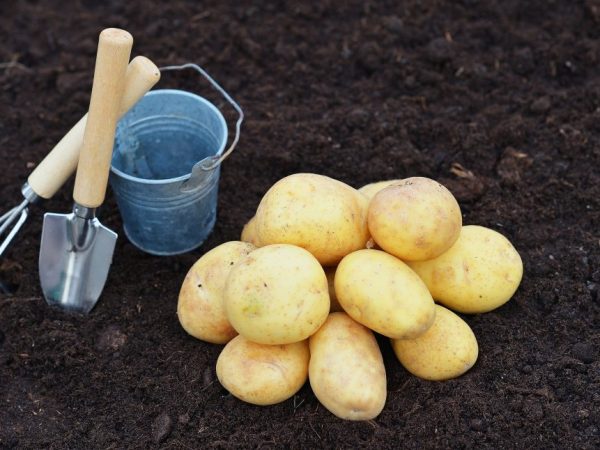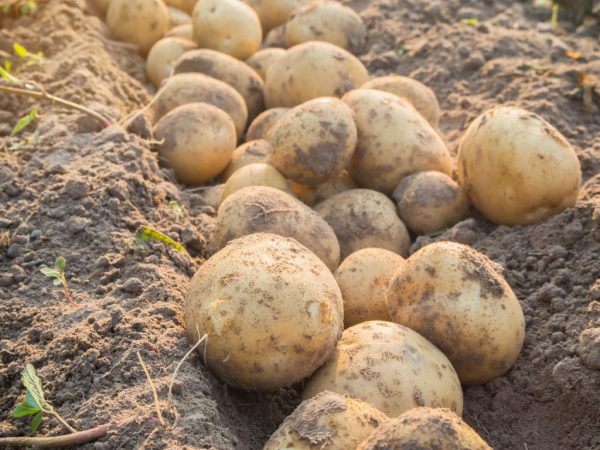Description of early potato varieties
Since potatoes are the most beloved vegetable in our region, breeders are constantly working on developing new varieties and improving existing ones. Scientists are working to improve the taste of the product. They also strive to make the vegetable resistant to disease. Consider which early potato varieties are popular today.

Description of early potato varieties
Ariel
This early potato variety was born thanks to the work of Dutch breeders. But, he perfectly took root in our region and is popular in Belarus. It is grown not only by summer residents, but also by large farmers. The first crop can be harvested already 45 days after planting. The time for full ripening is 55-60 days. The mass of tubers varies between 80-170 g, the color of the peel is beige, the bushes are medium-sized. With proper care, farmers collect 355 centners per hectare. But this is average. The Ariel variety allows you to harvest 2 times a year. If we are talking about regions with a short summer, you can collect two crops a year by growing a vegetable in a greenhouse. Potatoes of this variety are perfectly stored. According to statistics, only 6% of the tubers from the entire crop deteriorate quickly.
This variety is picky about the soil. Light and fertile soil suits him. It is not possible to obtain high yields on loamy soils. This early potato variety is resistant to the following diseases:
- potato cancer;
- common scab;
- golden cyst nematode;
- rolling leaves.
Diseases such as black leg and root rot occur only with poor care for this vegetable crop.
Ariel has a rich taste and does not change color during heat treatment. This potato variety is versatile in use. It works equally well for frying and boiling.
Gathering the crop, we dig out all the tubers. It is not worth waiting for the next year's harvest from the un-dug potatoes. She will not survive the winter frost.
Red Scarlet
Another early productive potato variety of Dutch origin, which has adapted to the climate of Russia. Red Scarlet is especially popular in the center of Russia. Harvested 65 days after the first shoots appear. At an earlier date, young potatoes are dug in. The mass of oblong tubers varies from 50 to 120 g. The rind is colored deep pink, taste is average. On one bush, as a rule, about 14 tubers are formed. The average yield is 230 centners per hectare. But with proper care, this figure increases 2-3 times. Red Scarlet potatoes are suitable for transportation.
When growing Red Scarlet, keep in mind that it is not drought tolerant and needs loose soil. Most often, yellow fruits are used for frying and cooking fries.
The Red Scarlet characterization points to one flaw in this potato. It is not resistant to late blight, so the tubers should be treated with fungicides before planting.
Luck
Luck is an early potato bred in Russia.It is worth noting that Russian breeders have been working on breeding a disease-resistant, thin-skinned variety for more than one year. The vegetable ripens 2 months after planting. But you can dig young potatoes already on the 40th day. The weight of the tubers varies from 150 to 200 g, the color of the peel is beige, the color of the pulp is yellow, the taste is good, the bushes are medium-sized and spreading. About 17 tubers are harvested from one bush. The average yield is 350 centners per hectare. In fruitful years, it turns out to collect 500 centners per hectare. It should be noted that the average yield of the Udacha variety does not change significantly in different years. Perhaps because of this stability, Luck is very popular with large farmers.

This variety can be grown on any soil
This variety is resistant to many diseases. Another advantage of potatoes Luck is its resistance to drought. Therefore, it can be grown in the territory of Donbass. This variety is susceptible only to nematodes. It is also worth noting that Luck adapts to any climatic conditions and is suitable for cultivation on a wide variety of soils. Not all varieties have such versatility. This potato can be grown even in the Urals and Siberia. Although, in the latter case, you will have to build a greenhouse.
Luck is suitable for long-term storage, and mechanical damage to the tubers does not lead to discoloration of the vegetable and its premature spoilage. Luck is the most popular potato in the Far East, Central Black Earth Region and the Volga Region.
If you do not want the potato tubers to darken when boiling, you should not apply potassium-containing fertilizers to the soil when growing the Luck variety.
Rosara
When talking about early potato varieties, one cannot ignore the Rosar variety, which was bred by German breeders. Harvest on the 65th day after the entrances appear. The mass of tubers, which have the shape of an oval, is, on average, 150 g, the bushes are medium-sized and semi-sprawling. The yield of one bush is 16-17 tubers. Some bushes produce 25 tubers. It is interesting that all tubers in the bush are almost the same size. The average yield is 400 centners per hectare.
Rosara is currently considered the most stable variety in terms of yield. Equally high yields are collected by farmers in hot and cold seasons, dry and rainy. It is also worth noting the resistance to all the most common diseases. There is no need to update the planting material for 5 years. Not all early potato varieties have this feature. Most of them have to be updated in 2-3 years.
Rosara is suitable for transportation and winter storage, has good taste. It is suitable for both cooking and frying. But it is better to use Rosara for making mashed potatoes and salads.
You can grow Rosara from seeds that are sown in the middle of winter. Seeds purchased in specialized stores are soaked in water before sowing. It is most convenient to sow seeds in boxes, which are covered with foil before the first shoots appear. It is worth waiting for shoots in 10-15 days. As soon as the seedlings get stronger, and the soil on the site warms up, we proceed to planting. We will not give a detailed description of this technology for growing vegetables in this way. But planting potatoes with tubers is much easier.
Bellarosa
This early potato was developed by German breeders. It is popular in Russia, Ukraine and Moldova. Its advantage is early maturity. Harvesting is possible within 50 days after planting. Young potatoes begin to be dug out on the 40th day. In regions with a warm climate, 2 crops are harvested per year. But to get two harvests, you need to plant potatoes in early spring.
The weight of the tubers varies from 115 to 210 g, the color of the peel is red or light pink, the taste is good, the bushes are tall.Bellarose is used more often for cooking. About 7-8 tubers are harvested from one bush. The average yield is 250 centners per hectare.
Cultivation of Bellarose is possible in non-irrigated areas, since it tolerates drought well. It is undemanding to the soil. Bellarosa grows equally well on all soils except clay. It is suitable for transportation and winter storage, and is resistant to common diseases. During storage, we periodically sort out the harvest. Potatoes that have sprouted cannot be eaten. We put it off for landing.
Priekulsky
The Priekulsky variety is especially popular among farmers in the Moscow region. The weight of tubers, which have the shape of an uneven circle, varies from 77 to 130 g, the color of the peel is white or light yellow. The yellow color of the flesh matches the peel of the potato. Bushes are short and semi-spreading or erect. About 7-8 tubers are harvested from one bush. The average yield is 200 centners per hectare. The taste is rather mediocre, but the tubers are suitable for winter storage.
Priekulsky potatoes are resistant to cancer, but often suffer from late blight. The peculiarity of the Priekuli potato is that its stem quickly begins to tilt towards the ground. Accordingly, the bushes should be hilled as early as possible. As the bush grows, you also need to huddle it. We repeat this procedure as much as necessary so that the bush does not lie on the ground.
Impala
Impala is another popular early yielding potato variety. It is the result of the work of Dutch breeders. Impala can be called a super early variety, since the crop can be harvested as early as 1.5 months after the first shoots appear. But, it is worth making a reservation that the ripening time largely depends on climatic conditions. In a short time, a tall and powerful bush is formed. The average yield is 270 centners per hectare. The vegetable has good taste. When boiled, yellow potatoes do not change color.
Impala is grown in almost all regions of Russia, but it is most popular in the Leningrad Region and the Moscow Region.
We reviewed the description of those varieties that are not difficult to grow in Russia. But these are not all good varieties. Such varieties as Spring, Caprice and Early Morning were ignored. But the characteristics of their yield are lower than the varieties described above, or they are not resistant to diseases.
Conclusion
We have looked at the most common early potato varieties with high yields. Many people mistakenly believe that there is a forty-day variety. This is a whole group of fruitful potato varieties that ripen early. From the name you can guess that the ripening period is 40 days. They allow you to get 3 crops per year. But, almost all forty days are not suitable for winter storage.
Update the planting material periodically, as over time, the tubers lose their taste and yield indicators drop. It is better to go for planting material to farms where breeding work is underway. On the territory of Belarus, for example, a good seed vegetable can be purchased in the village of Samokhvalovichi (Minsk region). Before planting tubers, we germinate them. The disadvantage of all varieties that are suitable for winter storage is that they do not germinate well. Germination technology involves placing the planting material in a warm and sunny place.


